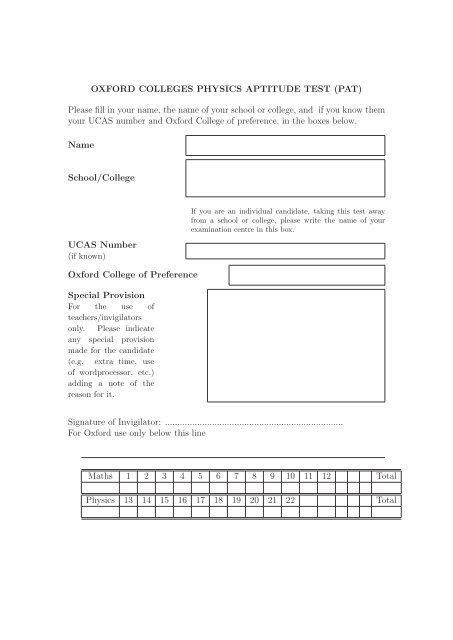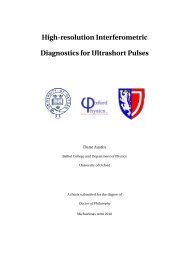OXFORD COLLEGES PHYSICS APTITUDE TEST (PAT) Please fill ...
OXFORD COLLEGES PHYSICS APTITUDE TEST (PAT) Please fill ...
OXFORD COLLEGES PHYSICS APTITUDE TEST (PAT) Please fill ...
Create successful ePaper yourself
Turn your PDF publications into a flip-book with our unique Google optimized e-Paper software.
<strong>OXFORD</strong> <strong>COLLEGES</strong> <strong>PHYSICS</strong> <strong>APTITUDE</strong> <strong>TEST</strong> (<strong>PAT</strong>)<br />
<strong>Please</strong> <strong>fill</strong> in your name, the name of your school or college, and if you know them<br />
your UCAS number and Oxford College of preference, in the boxes below.<br />
Name<br />
School/College<br />
UCAS Number<br />
(if known)<br />
If you are an individual candidate, taking this test away<br />
from a school or college, please write the name of your<br />
examination centre in this box.<br />
Oxford College of Preference<br />
Special Provision<br />
For the use of<br />
teachers/invigilators<br />
only. <strong>Please</strong> indicate<br />
any special provision<br />
made for the candidate<br />
(e.g. extra time, use<br />
of wordprocessor, etc.)<br />
adding a note of the<br />
reason for it.<br />
Signature of Invigilator: ........................................................................<br />
For Oxford use only below this line<br />
Maths 1 2 3 4 5 6 7 8 9 10 11 12 Total<br />
Physics 13 14 15 16 17 18 19 20 21 22 Total
THE <strong>COLLEGES</strong> OF <strong>OXFORD</strong> UNIVERSITY<br />
<strong>PHYSICS</strong><br />
Wednesday 7 November 2012<br />
Time allowed: 2 hours<br />
For candidates applying for Physics, Physics and Philosophy, Engineering or<br />
Materials<br />
There are two parts (A and B) to this test, carrying equal weight.<br />
Answers should be written on the question sheet in the spaces provided and you<br />
should attempt as many questions as you can from each part.<br />
Marks for each question are indicated in the right hand margin. There are a<br />
total of 100 marks available and total marks for each section are indicated at the<br />
start of a section. You are advised to divide your time according to the marks<br />
available, and to spend equal effort on parts A and B.<br />
No calculators, tables or formula sheets may be used.<br />
Answers in Part A should be given exactly unless indicated otherwise. Numeric<br />
answers in Part B should be calculated to 2 significant figures.<br />
Use g = 10 m s −2 .<br />
Do NOT turn over until told that you may do so.
Part A: Mathematics for Physics [50 Marks]<br />
1. Find the area between y = x 2 and y =| x |. [4]
2. (i) Write down the binomial expansion of (4 + x) 4 .<br />
(ii) Hence or otherwise evaluate (4.2) 4 to 2 d.p (decimal places). [4]
8<br />
3. Evaluate (2 + 4 r ). [3]<br />
r=1
4. Consider a square inside a circle of radius r as shown. What is the shaded<br />
area in terms of r [3]
5. Show x = 1 is a solution to x 3 − 6x 2 − 9x + 14 = 0 and find the other<br />
solutions. [4]
6. Find the equation of the line passing through (0, 2) and just touching y = (x − 2) 2<br />
at x > 0. [4]
7. If 5 = log 2 16 + log 10<br />
√<br />
0.01 + log3 x, determine x. [4]
8. Consider two dice – one contains the numbers 1-6, the other contains only<br />
1,2,3 each shown twice (i.e. 1,2,3,1,2,3). What is the probability that when<br />
we roll the two dice we will obtain a score of 7 [4]
9. Solve cos 2 θ + sin θ = 0 for θ. Leave your answer in terms of sin θ. [4]
10. Sketch an example of a real function f(x) defined for all real arguments x,<br />
which has all of the following properties:<br />
(a) f(x) > 0 for all x,<br />
(b) f(x) is a continuous function,<br />
(c) df<br />
dx<br />
= 0 only for x = 4,<br />
(d) d2 f<br />
dx 2 = 0 only for x = 2 and x = 6.<br />
[4]
11. Solve −1 < − 1 + 2x < 1. [6]<br />
x
12. Sketch y = 1 − x − x2<br />
x 2 . [6]
Part B: Physics [50 Marks]<br />
Multiple choice (10 marks)<br />
<strong>Please</strong> circle one answer to each question only.<br />
13. A vintage steam locomotive made of iron has a mass of 6.5x10 4 kg and is<br />
10 m long. How long is its scale model which is also made out of iron and<br />
has a mass of 1 kg<br />
A 4 cm B 20 cm<br />
C 25 cm D 30 cm [2]<br />
14. A gas cylinder has a volume of 0.02 m 3 and contains 88 g of carbon dioxide at<br />
a temperature of 27 ◦ C. The molar gas constant R 8.3 Jmol −1 K −1 . What<br />
is the gas pressure<br />
A 101 kPa B 149 kPa<br />
C 201 kPa D 249 kPa [2]<br />
15. An electric car has a battery pack delivering 160 V and 100 A of steady<br />
current when moving at 36 km/h. What is the air resistance, assuming<br />
100 % efficiency<br />
A 440 N B 1600 N<br />
C 2000 N D 3200 N [2]<br />
16. A cube painted black is cut into 125 identical cubes. How many of them are<br />
not painted at all<br />
A 21 B 25<br />
C 27 D 30 [2]
17. A massive slider starts from rest from a point S (which is at the same height<br />
as a point T at the top of the track) and slides along a frictionless circular<br />
track as sketched in figure below. The slider<br />
A does not get to T.<br />
B gets to T and falls straight down.<br />
C gets to T but then, leaves the track and falls down following a parabola<br />
trajectory to the left.<br />
D passes T staying on the track all the way through. [2]
Written answers (20 marks)<br />
18. A 12V battery, a voltmeter, an ammeter and a resistor R = 2 kΩ are sketched<br />
in figure (a) below.<br />
Sketch connections to create a circuit to measure a potential difference across<br />
the resistor and an electric current. How big is the current [1]<br />
A capacitor C = 4 µF and a switch S, as sketched in figure (b), are inserted<br />
into the circuit. Sketch how the current depends on time from the moment t e<br />
when the switch is moved to e closing the circuit. Estimate the time T after<br />
which the current is not changing significantly. After a time t d much longer<br />
than T , the switch is moved to d. Sketch the current from that moment<br />
until the moment when the current is not changing significantly, indicating<br />
on your sketch the time interval T . [3]
19. A loudspeaker L is placed between a microphone M and a screen S reflecting<br />
sound waves as sketched below. The loudspeaker emits sound of fixed wavelength<br />
λ in all directions. When the screen is moving slowly, to the right along the<br />
x direction (slowly in comparison with the speed of sound), the microphone<br />
records minima and maxima of the sound intensity. What is the distance<br />
between two screen positions giving two successive maxima Would the<br />
microphone record minima and maxima if (a) the loudspeaker or (b) the<br />
microphone is moving along x direction instead of the screen [4]
20. The 238 U isotope has a half-life T 238 = 4.5x10 9 years and the 235 U has<br />
T 235 = 7.0x10 8 years. N 238 (t) is the number of 238 U nuclei at time t and<br />
N 235 (t) is the corresponding number for 235 U. The relative abundance r(t)<br />
. At present, r = 0.0072. Estimate the relative<br />
abundance of these two isotopes 10 9 years ago. You might use the following<br />
approximations: e x 1 + x for small x, e 2.7 and ln 2 0.7. [4]<br />
is defined as r(t) = N 235(t)<br />
N 238 (t)
21. A meteoroid of mass m is on a circular Earth orbit of radius R which is a few<br />
(> 2) times larger than the radius of the Earth R E . Derive an expression for<br />
the meteoroid’s speed. State the meanings of all symbols used. [2]<br />
Another meteoroid of the same mass is on the same orbit, in the same plane<br />
but rotating in the opposite direction. At an azimuthal angle ϕ 0 , see figure<br />
below, the two meteoroids collide head-on and coalesce (combine). Sketch<br />
the complete trajectory of the newly formed double mass meteoroid showing<br />
how the azimuthal angle ϕ depends on the distance r. Sketch also its kinetic<br />
energy and expected meteoroid surface temperature as a function of r. Give<br />
a very brief explanation of why you expect the temperature to depend on<br />
r that way. For r < 2R E effects due to the Earth’s atmosphere can not be<br />
neglected; r is the distance from the Earth’s centre. [6]
Long question (20 marks)<br />
22. A point like object with mass m = 1 kg starts from rest at point x 0 = 10 m<br />
and moves without any friction under a force F which depends on the<br />
coordinate x as illustrated in figure below. The motion is confined to one<br />
dimension along x.<br />
<br />
<br />
<br />
<br />
<br />
<br />
<br />
<br />
a1 What is its speed at x = 0 [2]
a2 Sketch its kinetic energy as a function of x. [4]
a3 Sketch its velocity as well as its acceleration as a function of time t. [6]
Now consider a case when, in addition, a friction force of a magnitude of 1 N<br />
is present for x ≥ 0.<br />
b1 Sketch how the velocity depends on x in that case. [6]
2 How many meters this point like object travelled during the time when<br />
its position coordinate x was ≥ 0 [2]










![Extended Notes 8 [pdf]](https://img.yumpu.com/50123548/1/190x245/extended-notes-8-pdf.jpg?quality=85)




![Handout 3 [pdf] - University of Oxford Department of Physics](https://img.yumpu.com/46475432/1/190x245/handout-3-pdf-university-of-oxford-department-of-physics.jpg?quality=85)